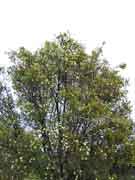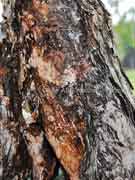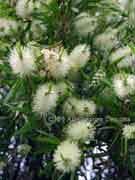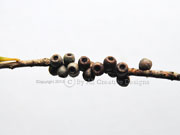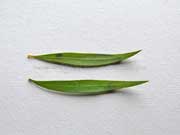
< Expand the Menu to access our Tree Identification Pages
Fig & Rainforest Tree Species Identification Photos, Australia
This web page shows identification images of Australian native fig (Ficus spp.) and rainforest tree species. Photos depict the full tree, bark, fruit and leaf samples.
Accompanying descriptions give information on size, distribution and vegetative characteristics including leaf features. The Rainforest of Australia's East Coast book lists fig trees in printed format.
Species in following genera are listed in groups on our web pages: Australian Fig trees (Ficus spp.), Eucalypts (Eucalyptus spp.), Grevilleas (Grevillea spp.) and Lilly Pillies, Satinashes ( Syzygium species). Otherwise all native Australian tree species are listed by common name in alphabetical order. The content of this web page is constantly extended, revised and updated. Please contact us to purchase high resolution photos. Refresh the page in your browser to view updated content.
JUMP TO: Fa - Fl
Australian Fig Trees
A common feature of Australian Fig trees are 2 stipules (sheaths) enclosing and protecting the emerging leaf, which will fall off as the leaf unfurls. Stipules of the Moreton Bay Fig (Ficus macrophylla) are up to 15cm long, whereas stipules of other Ficus species, such as the Sandpaper Fig (Ficus fraseri) might only measure 5mm in length. (See Leaf Characteristics Page for further information). When petioles (leaf stalks), branches or bark is broken a sticky sap will be excreted. This sap can be clear to milky white or pale yellowish and congeals on exposure. Flowers, situated within the fig (receptacle), are pollinated by tiny wasps, which gain access through a small opening at the apex, called an ostiole. After successful pollination the fig produces large numbers of small seeds. All Ficus species belong to the family MORACEAE.
Cluster Fig Ficus racemosa
Cluster Fig Ficus racemosa Other names: Red River Fig
This fig tree species can reach a height of more than 25m when competing for available sunlight within rainforests. The Cluster Fig has a far reaching distribution range and inhabits various environments such as subtropical, tropical and monsoonal rainforests. It is also found along permanent watercourses in drier habitats. In exposed coastal environments it may only reach a height of less than 10m. As the common name suggests the ripe fig arranged in dense clusters is a distinguishing feature (Image 1). Older trees can develop an extensive buttress root system. The bark is grey and on older trunks becomes rough and scaly (tessellated) (2). The fruit (fig) is depressed pear-shaped (pyriform) or more rounded (globose), up to 3.5cm long and turns an orange reddish colour when fully ripe. It is produced in clusters on the trunk (cauliflorous) and on older branches (ramiflorous) (3 & 4). Simple leaves with an alternate arrangement are varied in length; from 6 to 20cm long, ovate (egg-shaped) or broadly lanceolate (lance-shaped) with entire margins, hairless when mature, dark green, semi-glossy, relatively thick and somewhat leathery. The lamina (leaf blade) is noticeably raised between the lateral veins; up to 8 pairs are present. Stipules are up to 2cm long and persist at the base of the petiole (leafstalk) which reaches a length of 7 cm. A whitish milky sap exudes when the leaf stalk is broken. Leaf base shape is broadly wedge-shaped (cuneate) to rounded (oblique) (5). Distribution: QLD, NT and WA. Widespread over Asia.
Creek Sandpaper Fig Ficus coronata
Creek Sandpaper Fig Ficus coronata
This small to medium sized tree can display an unusual spreading habit in form of branches that touch the ground having the ability to root and produce upright shoots. It is found mainly along watercourses in subtropical and warm temperate rainforests (Picture 1). Bark is fairly smooth and brown in colour if not covered by mosses and lichen (2). Leaf arrangement is alternate (3). The fruit is a small fig that is supported by a stalk up to 2.5cm long. The fig is hairy and purple to nearly black in colour when fully ripe. Fruit can appear on older trunks (cauliflorous Picture 2) (4). Simple leaves on adult trees are; alternately arranged, up to 13cm long, oblong or sometimes ovate (egg-shaped) with mostly fine toothed margins, hairy on the lower surface and feel very sandpaper like. Stipules are up to 12mm long. Juvenile leaves are larger and margins (leaf edges) can be entire or finely crenate. A clear sap exudes when leaf stalk is broken (5). Notes: One of the best species for creek or river bank stabilisation, figs can be sweet and palatable. Distribution: Vic, NSW and Qld. See also Sandpaper Fig Ficus fraseri below.
Deciduous Fig Ficus superba var. henneana
Deciduous Fig Ficus superba var. henneana Other names: Superb Fig
Under the right conditions this species can develop into a massive tree up to 35m high with a far reaching canopy. It has a strangling habit and often starts life on a host tree (epiphytic). Preferred habitats for best development are moist coastal locations, such as rainforests and permanent watercourses. This species is semi-deciduous and rarely shed all its leaves (1). On older trees the base of the trunk becomes buttressed and tangled with roots. Bark is shades of grey in colour with a firm and finely rough texture (2). Stipules enclosing the emerging leaves are only up to 10mm long. A white sap exudes when the leaf stalk (petiole) is broken (3). Simple leaves with an alternate arrangement are; up to 12cm long, varied in shape from ovate to broad oblanceolate (reverse lance-shaped) or elliptic with entire margins, hairless, dark green, glossy on top, paler green beneath, thinner than most other strangling fig species (4). The petiole is up to 7cm long and grooved on top. A joint between the lamina (leaf blade) and the leaf stalk is distinctive. The leaf narrows into a cordate base shape (5). Distribution: From the south coast of NSW to northern Qld and NT.
Drupe Fig Ficus drupacea
Drupe Fig Ficus drupacea Other names: Brown-woolly Fig, Mysore Fig, Hairy Fig, Red Fig
This fig tree has an expansive natural distribution range throughout South-East Asia, Pacific Islands and northern Queensland. It has a strangling habit with the potential to reach a height of more than 30m and inhabits different forms of tropical rainforests and other drier environments (Picture 1). Multiple trunks and above ground buttress roots are a common feature, but arial roots seem to be absent. Bark is grey, firm and shows horizontal lines of small blisters (lenticels) and fine ridges (2). The fruit has variations in either being smooth (hairless) or being densely covered in woolly hair (Image 3 inset; left). The smooth and reddish brown fig reaches a length of 25mm, whereas the woolly variation shown is more than 30mm long. Both variations are stalk-less (sessile) and oblong or more olive-shaped (common drupe shapes). The fig is edible but tastes rather bland (3 & 4). Simple leaves with an alternate arrangement are; up to 20cm long, mostly hairless when mature (var. drupacea), ovate (egg-shaped) or broadly elliptical with entire margins, dark green on top, paler green beneath, thick strong and leathery in texture. Venation is prominent and raised on lower leaf surface. Stipules are up to 4cm long. Small amounts of milky sap oozes from broken petioles (leaf stalks), which are up to 4cm long (5). Distribution: Cape York and northern Qld. Note: Ficus drupacea var. drupacea produces hairless figs; Ficus drupacea var. pubescens has woolly hairy figs.
Figwood Ficus virgata
Figwood Ficus virgata
Usually the Figwood employs a strangling habit to overgrow other trees, but it is also able to be a free-standing tree that reaches a height of more than 20m. Tropical and gallery rainforests at lower altitudes are preferred habitats (Image 1). Bark colour is grey and texture is relatively smooth with small horizontal ridges being a feature. Older specimens develop a buttress root system (2). The edible fruit, a small rounded fig, reaches a diameter of about 10mm and features a broad protrusion at the apex. Depending on maturity, it is yellow or orange and changes to brown or sometimes red with age (3). Simple leaves with an alternate arrangement are; up to 20cm long, oblong or more ovate (egg-shaped) with entire margins, hairless, dark green, glossy on top, paler green beneath, strong and rather leathery in texture. Stipules, protecting the leaf buds, are up to 15mm long and a small amount of watery sap is excreted when a leaf stalk is broken. Venation is conspicuous on both surfaces and a small gland at the base (red circle) is normally visible (4 & 5). Distribution: Tropical northern Qld.
Rainforests of Australia's East Coast, HAND SIGNED BOOKS; (Out of Stock) A practical and informative field guide to the identification of native rainforest species. More than 800 colour photographs, informative graphics, maps and detailed description of more than 300 species.
This book is a valuable information source for bushwalkers, students, gardeners and anyone with an interest in Australia’s native flora.
The book was written and illustrated by the author of the tree identification web pages.
New Holland Publishers: May 2019
ISBN: 9781925546293
Format: Paperback with PVC
Pages: 304 pp.
Size: 23 cm high x 15 cm wide
Full Colour Photography
Rainforests: Identification - Evolution - Reproduction
Dedicated photography of rainforest species including; mosses, mushrooms, lichens, slime moulds, ferns, conifers, flowering trees, climbing plants, orchids and palms enable the reader to identify commonly encountered species.
CLICK HERE FOR MORE INFORMATION
Hairy Fig Ficus hispida
Hairy Fig Ficus hispida
This small fig tree species occurs as an understorey species within tropical rainforests and rarely attains more than 10m in height. It lacks a strangling habit (Picture 1). Bark is olive brown in colour and densely covered in small blisters (lenticels) that create a finely rough texture (2). Edible figs develop on the main trunk (cauliflorous), on old branches or young twigs and are supported by strong stalks up to 4cm. Figs change from green to a yellowish brown colour when fully ripe and measure up to 3cm in diameter (3 & 4). Simple leaves with an opposite arrangement are thinner and softer than many other native Ficus species. Leaves are: up to 35cm long with varied margins from entire to crenate, elliptic to lanceolate (lance-shaped) or oblanceolate in shape, dark green, glossy on top, paler green, also glossy beneath with a finely rough texture, due to short and stiff (bristle-like) hair. Petiole is up to 8cm long and excretes a pale yellowish latex when broken. Leaf apex is acute or acuminate ending in a fine point, base shape is rounded to cordate. Mid rib and prominent laterals veins are raised on lower leaf surface (5). Distribution: From central to northern Qld.
Moreton Bay Fig Ficus macrophylla
Moreton Bay Fig Ficus macrophylla Other names: Black Fig, Figwood
The natural habitat of these massive trees are subtropical rainforests. It has a strangling habit, starting life on a host tree, and prefers growing in proximity to watercourses (Picture 1). Older specimen feature large trunks with above ground buttress roots able to extend beyond the reach of the canopy. Bark is shades of grey, firm in texture and displays distinct horizontal ridges (2). Figs appear paired in leaf axils and turn a purple colour speckled with white dots when fully ripe. They are up to 30mm long and borne on tough stalks (3 & 4). Simple leaves are up to 25cm long are and display a varied leaf arrangement, i.e. sometimes opposite, sometimes alternate. They are; oblong to ovate in shape with entire margins, hairless, dark green on top, brownish on their underside, thick and leathery. Strong petioles (leaf stalks) are up to 10cm long and exude a sticky white sap when cut or broken. Stipules are up to 15cm long (4 & 5). Notes: Important feed tree for a range of rainforest pigeons, fruit doves and flying foxes. Diversity of tree species growing under and close to Moreton Bay Figs is immense. Its seed will not germinate when in contact with the soil and within reach of its own roots. Distribution: From the mid north coast of NSW to Qld.
Red-leaved Fig Ficus congesta var. congesta
Red-leaved Fig Ficus congesta Other names: Cluster Fig
This small fig species rarely reaches more than 5 to 6m in height, i.e. a tall shrub or sometimes small tree. Despite its diminutive height, trunks are disproportional large in diameter on older specimens. It is an evergreen species without a strangling habit (Picture 1). Bark on the trunk is greyish brown in colour with a finely rough and in some places wrinkled texture (2). Abundant fruit (figs) are produced on the trunk and along smaller branches. Figs measure up to 2cm across and become yellowish when fully ripe (3). The very attractive foliage flushes in peach to copper colours, which is a distinguishing feature for this species. Stipules covering leaf buds are up to 25mm long (4). Broken leaf stalks exude a milky sap, which becomes sticky on exposure. Simple leaves with an alternate arrangement are; up to 25cm long, elliptic in shape with finely crenate margins, dark green when mature, hairless or finely hairy, relatively thick and leathery in texture. The strong and brown coloured petiole (leaf stalk) is up to 6cm long. (5). Distribution: From central to northern Qld and NT.
Round Leaf Banana Fig Ficus crassipes
Round Leaf Banana Fig Ficus crassipes Other names: Banana Fig
The common name relates to the distinctive rounded leaves and the fruit being somewhat banana-shaped. It has a strangling habit, reaches a height of 20m and is found within tropical upland rainforests (Image 1). Bark is grey and marked by blisters (lenticels) forming irregular and mostly horizontal lines on the trunk and older branches (2). The fruit (fig) reaches a length of 70mm and the apex terminates in a characteristic beak. The fig varies in colour from yellowish brown to purple and is supported by a short stalk (3). Leaves with an alternate arrangement cluster towards the end of younger branches. Sharply pointed stipules, covering the emerging leaves, are up to 12cm long. Simple leaves are: up to 16cm long, rounded in shape (orbicular) with entire margins, hairless, dark green on top, paler green beneath, thick and leathery in texture. The prominent leaf stalks are up to 14cm long and exude a milky sap when broken. Fine reticulate venation is more visible on the lower leaf surface (4 & 5).Distribution: Tropical rainforests of North-eastern Qld.
Rusty Fig Ficus rubiginosa
Rusty Fig Ficus rubiginosa Other names: Port Jackson Fig, Rock Fig
The Rusty Fig or Port Jackson Fig reaches a height of 20m and develops a wide spreading canopy. It prefers rocky, well drained positions and can be found growing close to the shoreline (Picture 1). The bark is firm, with some horizontal ridges showing, and light grey in colour (2). The globe-shaped fig is up to 2cm long and supported by a stiff stalk. Figs grow in pairs and will turn more orange-red when fully ripe. Stipules are up to 5cm long (3 & 4). Simple leaves with an alternate arrangement are; up to 11cm long with entire margins, ovate to broad elliptic in shape, dark green and glossy on top, pale green to rusty brown beneath, thick and leathery in consistency. The underside of the leaf is covered in fine brown silky hair. The strong petioles (leaf stalks) are up to 4cm long and excrete a milky sap when broken (5). Distribution: Within coastal and subtropical rainforests from NSW south coast to central Qld.
See
Leaf -
Flower - Fruit - and Bark Identification Web Pages for explanations of botanical definitions and concepts.
Select images for Full Size View. (Opens new browser window).
Use the Key to Species, which is based on leaf characteristics, to identify native trees and shrubs found on Australia's east coast.
Sandpaper Fig Ficus fraseri
Sandpaper Fig Ficus fraseri
The Sandpaper Fig reaches a height of more than 20m and can be found in different types of rainforests, especially in locations close to the coast (Picture 1). Bark has got a hard, rather smooth texture and is a dark greenish-brown in colour (2). Foliage of juvenile specimens and leaves borne under minimal light conditions on the lower branches of older trees are deeply lobed (3). Young branches are rough, but not covered in hair as is the case for the Creek Sandpaper Fig Ficus coronata. Stipules are less than 10mm long (4). The simple leaves of adult specimens feature a mostly alternate arrangement. They are; up to 13cm long with entire margins, broad elliptic to ovate in shape with an acute apex and have a rough sandpapery texture (5). Distribution: NSW central coast to central Qld. Note: Leaves are not as thick and rough compared to that of the Creek Sandpaper Fig.
Small-fruited Fig Ficus microcarpa
Small-fruited Fig Ficus microcarpa Other names: Indian Laurel Fig, Curtain Fig
This impressive fig produces an abundance of aerial roots which after reaching the ground thicken and support the spreading crown.
Within tropical rainforests it can develop into a tall tree more than 25m in height with a large crown and a maze of vertical roots,
but is considerably smaller in drier locations (Picture 1 & 2). Bark is firm and a reddish-brown to more greyish brown in colour (3). Stipules enclosing the growing bud are up to 2cm long. White sap exudes when the petiole (leaf stalk) is broken (4). Simple leaves with an alternate arrangement are; up to 10cm long, mostly obovate (reverse egg-shaped) with entire margins, dark green on top, light green beneath, hairless, smooth and fairly thick in texture. At up to 2cm long, the petiole (leaf stalk) is strong but relatively short (5). Distribution: From central to northern Qld and Asia.
Small-leaved Fig Ficus obliqua
Small-leaved Fig Ficus obliqua
Older specimens of this large strangling fig tree develop short massive trunks and large limbs, which support a widespread canopy. It naturally occurs within subtropical rainforests, but old trees can also be encountered on cleared farmland (Picture 1 & 2). At only 10mm in diameter, the fig is relatively small and turns from yellow to an orange colour with maturity. The stalk, supporting the fig, is inconspicuous and only a few millimetres long (3). Stipules are 3 to 4cm long. Only a small amount of sap will exude when a leaf stalk is broken (4). Simple leaves with an alternate arrangement are; up to 8cm long, broadly elliptic to obovate (reverse egg-shaped) with entire margins, firm, leathery in texture, but not as thick as many other fig tree species. The petiole (leaf stalk) is up to 3cm long, strong, rigid and flattened in shape (5). Distribution: NSW south coast to central Qld.
Strangler Fig Ficus watkinsiana
Strangler Fig Ficus watkinsiana Other names: Watkin's Fig
This magnificent and very large fig tree species has a strong strangling habit. It is able to overgrow other tall rainforest tree species, such as the Yellow Carabeen Sloanea wollsii and is thereby able to reach a height of 50m (Picture 1, 2 & 3). After the host tree dies and decays a hollow centre is left (4). Simple leaves with an alternate arrangement are; up to 22cm long, lanceolate (lance-shaped) with entire margins, hairless, smooth, rather thick and leathery in texture. The petiole (leaf stalk) is up to 4cm long and exudes a milky sap when broken. Stipules are up to 6cm long. The fig turns a very dark purple colour when fully ripe and is more oval-shaped when compared to the Moreton Bay Fig Ficus macrophylla. The fruit is up to 4cm long, 2.5cm wide and features a distinct protrusion (nipple) at the apex (5). Distribution: from the mid-north coast of NSW stretching to subtropical Qld.
Descriptions and all images copyright ©2023 by www.allcreativedesigns.com.au world wide rights reserved.
Click Images for Full Size View
Weeping Fig Ficus benjamina
Weeping Fig Ficus benjamina Other names: Benjamin Fig
In its natural habitat of tropical rainforests, the Weeping Fig can be a large tree more than 30m tall with a spreading crown and extensive buttress roots. In drier locations it is largely reduced in size. This Fig tree species is one of the most cultivated in the world and used as an indoor and outdoor ornamental plant. There are a number of cultivars in existence, some with variegated (white edged) leaves (Picture 1). The bark is marked by small ridges and blisters, mostly shades of grey in colour and hard in texture (2). Figs change from green to red to a dark purple when fully mature and measure up to 12mm in diameter. They are globose (rounded) in shape and characteristically sessile (attached without a stalk) (3). Stipules, protecting the newly emerging leaves, are up to 2cm long and turn brown before falling off. The petiole (leaf stalk) is only up to 2.5cm long, grooved on top, and relatively delicate for a Ficus species. Generous amounts of white sap will exude when a leaf stalk is broken (4). Simple leaves with an alternate arrangement are; up to 10cm long, elliptic to broadly lanceolate (lance-shaped) with entire margins, glossy dark green on top, smooth and relatively thin. Leaf apex is typically acuminate ending in a fine tip; base shape is rounded (5). Distribution: Northern Qld and NT, but planted in many other parts of Australia.
White Fig Ficus virens
White Fig Ficus virens Other names: Mountain Fig
The White Fig is a massive tree species with a strong strangling habit, occurring in subtropical and tropical rainforests (Picture 1). Bark is firm and rather smooth with some bumps and ridges. Colour is a light to medium grey (2). The fruit (figs) are borne in pairs and are attached without a stalk (sessile). They are globose (globe-shaped) and measure up to 2cm in diameter (3). Stipules are rather short, measuring only up to 15mm in length. Petioles (leaf stalks) are up to 6cm long and excrete a white sap when cut or broken (4). Simple leaves with an alternate arrangement are; up to 18cm long, oblong in shape with entire margins, mid green on top, lighter green beneath, smooth and thinner than the leaves of species such as the Moreton Bay or Strangler Fig. Leaf apex is typically acuminate, base shape is broadly rounded (5). Distribution: NSW north coast to tropical Qld, NT and WA. 2 variations: sublanceolata and virens.
Green Guide Trees of Australia
How to recognise Australian tree families and genera.
A practical field guide to the identification of native species. More than 200 full colour photographs and detailed descriptions explaining leaf, bark, flower, fruit and other tree characteristics. The guide was written and illustrated by the author of these web pages.
New Holland Publishers: January 2016
Format: Paperback with PVC
Pages: 128 pp.
Size: 13 cm wide x 18 cm high
First Edition, Hand Signed Copies
CLICK HERE FOR MORE INFORMATION False Gardenia Atractocarpus sessilis
False Gardenia Atractocarpus sessilis
This attractive shrub or small tree is a close relative to the better known Brown Gardenia (Atractocarpus fitzalanii Page 2), originating in the tropical rainforests of North Queensland. The genus encompasses six species, of which two, the Native Gardenia (A. benthamianus Page 8) and the Thin-leaved Gardenia (A. chartaceus Page 11), are restricted to subtropical rainforests. A further species is endemic to Lord Howe Island. In its natural habitat the False Gardenia prefers to grow beneath taller trees and is characterised by its dense foliage (bushy growth) consisting of large leaves (Photo 1). Bark is brown in colour and has a firm texture marked by small vertical ridges (2). Beautifully scented flowers, characteristic for the genus, are up to 2cm long and typically emerge from axillary buds towards the end of young branches. At the apex, the white tubular corolla divides into 5 overlapping lobes up to 1cm long (3). The fruit (a berry) is somewhat varied in shape from rounded to more ovoid and 5 to 6cm long. It has a rough surface texture and turns yellowish green when ripe. The persistent flower calyx (base) can be seen at the top of the berry (4). Emerging leaves are protected by a stipule up to 2cm long. Simple leaves with an opposite arrangement are; more than 20cm long, broadly oblanceolate (reverse lance-shaped) with entire margins, hairless, dark green, glossy above, pale green beneath, very smooth and firm in texture. Mid rib and lateral veins are noticeably raised on upper leaf surface (5). Distribution: North Qld. See Flower Characteristics Page and Leaf Characteristics Page for information on terms used.
Feather Wattle Acacia o'shanesii
Feather Wattle Acacia o'shanesii
The Feather Wattle is a tall shrub or small tree species up to 10m tall that inhabits environments in proximity to the coast line (Picture 1). Bark is fairly smooth with fine fissures and pale reddish brown in colour (2). The beautiful yellow flower heads are globose (globe-shaped) and measure up to 8mm in diameter. They are borne on racemes and bloom for most time of the year (3). The fruit is a flattened pod up to 12cm long, which turns a reddish brown when fully ripe and contains up to 6 seeds (4). Bipinnate compound leaves with an alternate arrangement feature up to 17 pairs of pinnea per leaf, which hold more than 50 leaflets each. Leaflets are oblong in shape with a rounded apex and 3 to 4mm long (5). Distribution: NSW south and mid-north coast. See Flower Characteristics Page and Leaf Characteristics Page for information on terms used.
Featherwood Polyosma cunninghamii
Featherwood Polyosma cunninghamii
The Featherwood is normally a small native tree species reaching less than 10m in height and occurs as an understorey species within subtropical rainforests The specimen shown is about 12m tall; the larger trunk to the left in the image is a Crabapple Schizomeria ovata (Picture 1). Bark (on adult specimen) is brown in colour, rather firm in texture and features longitudinal shallow grooves (2). The cylindrical shaped flowers, coloured pale white at first, turn yellowish green with maturity and are pleasantly scented. They are borne on small racemes, measure up to 12mm long with 4 fused petals separating at the apex (3).
The appearance of the tree and its' foliage is similar to that of the Doryphora sassafras and some Socketwood (Daphnandra) species, but leaves differ in being oblanceolate (reverse lance-shaped), thinner and softer in consistency. Simple oppositely arranged (sometimes slightly offset) leaves are; up to 9cm long with regular toothed margins and callous tips (up to 7 on each side), mostly oblanceolate in shape, hairless, mid-green and very glossy on top, dull and paler below, rather thin with a soft and smooth texture. Leaf apex is acute with a callous tip, base is attenuate. Venation is clearly visible, showing an impressed (sunken) mid vein and laterals on the upper surface. Veins are more pronounced on lower leaf surface (4 & 5). Distribution: NSW south coast to southern Qld. Identification tip: Leaves are not scented, as is the case for the Doryphora sassafras Page 9.
Fern-leaved Banksia Banksia oblongifolia
Fern-leaved Banksia Banksia oblongifolia Other names: Dwarf Banksia, Rusty Banksia
This adaptable and common shrub is found from coastal heaths to dry open forests or woodlands on the tablelands and ranges. It has a sturdy and upright growth habit but only reaches a height of up to 3m (Image 1). Bark at the base of older stems/trunks is tones of grey in colour, and becomes rough and flaky. Bark on branches is reddish brown, relatively smooth but covered in small protrusions (lenticels) (2). The fruiting structure is typical for Banksia species and consists of up to 80 individual follicles that are horizontally attached to a vertical axis, i.e. the now swollen and hardened rachis of the inflorescence (flower spike). When immature, follicles are covered in short fine hair but they become smooth and woody at maturity. Mature follicles are up to 18mm long and split along one side to disperse 1 or 2 winged seeds (3). Young branchlets and emerging leaves are densely covered in furry rusty brown hair (4). Juvenile leaves are arranged in a whorl and change to an alternate arrangement thereafter. Simple leaves are; up to 11cm long, oblong or more oblanceolate (reverse lance-shaped) with widely spaced toothed margins, dark green on top, whitish beneath, hairless when mature (except for midrib on lower surface), strong and leathery in texture. The petiole (leaf stalk) is less than 10mm long (5). Distribution: Southern NSW to central Qld.
Fine-leaved Tuckeroo Lepiderema pulchella
Fine-leaved Tuckeroo Lepiderema pulchella
The Fine-leaved Tuckeroo Lepiderema pulchella is a rare native tree species, due to extensive clearing of forests growing on rich alluvial soils. Under favourable conditions, it can reach a height of up to 20m (Picture1). Bark is a dark greenish-grey in colour with a rather hard and smooth texture (2). Small white, cream and pale yellow coloured flowers measure up to 7mm in diameter and bloom in early spring. (3). The orange coloured fruit (a capsule) splits into 3 valves, each containing a brown seed, which is partly covered in a yellow aril (skin) (4). The pinnate compound leaves consist of 4 to 12 separate leaflets, which are; up to 10cm long, mostly lanceolate (lance-shaped) with undulating (wavy) margins, hairless, dark green, glossy on top, lighter green and glossy beneath, soft and smooth in texture. Apex is acute tapering to a fine point, base shape is cuneate. A prominent brown pulvinule (swelling) is visible at the base of the short petiolule (leaflet stalk), which is a good identification feature for this species (5). See Leaf Characteristics Page. Distribution: Small range in northern NSW and southern Qld.
Descriptions and all images copyright ©2023 by www.allcreativedesigns.com.au world wide rights reserved.
Click or Tap Images for Full Size View
Firewheel Tree Stenocarpus sinuatus
Firewheel Tree Stenocarpus sinuatus Other names: Wheel of Fire Tree
This handsome tree has a slender, upright shape even when planted in full sunlight and reaches a height of up to 25m (Picture 1). Bark is white to grey in colour, hard and rough in texture with longitudinal fissures appearing on older specimens (2). Very impressive and unusual flowers are arranged in umbels and can cover the whole tree in midsummer (3). The fruit (a follicle) is up to 8cm long and after splitting on side only releases numerous papery winged seeds (4). Alternatively arranged simple leaves of mature trees are; up to 30cm long with undulated margins, very varied in shape from deeply lobed to obovate (reverse egg-shaped), hairless, glossy on both surface, firm and stiff in consistency (5). Distribution: from the mid north coast of NSW to central Qld.
Fishtail Silky Oak Neorites kevedianus
Fishtail Silky Oak Neorites kevedianus Other names: Fishtail Oak
The common name, Fishtail Silky Oak, relates to the fishtail-shaped leaves/leaflets and the wood grain resembling that of a European Oak tree. This tree only exists in the tropical rainforests of northern Queensland, where under favourable conditions it can reach a height of 25m (Picture 1). The normally straight trunk is covered in a distinctive brownish bark that features horizontal lines of small lenticels (protrusions) and fine ridges. Image shows bark after prolonged rain (2). The fruit, a follicle, hardens with full maturity and is up to 7cm long. It splits along one side to disperse a number of flattened and rounded seeds, which are attached to a brown and dry papery wing (3). Young trees and shoots developing at the base of the trunk (coppice shoots) feature attractive conspicuous foliage, consisting of large pinnate compound leaves with up to 25 fishtail-shaped leaflets (4). Whereas the canopies of mature trees bear simple leaves with an alternate arrangement. Adult leaves are; up to 20cm long, varied in appearance, from ovate (egg-shaped) to diamond-shaped (rhombic) to more elongated and uneven sided with toothed margins, dark green, hairless on top when mature, paler green and rusty hairy on veins beneath, strong and firm in texture. The lamina might be crinkled or leaf margins are wavy (5). Distribution: North-eastern Qld. Note: A very interesting native ornamental tree that will grow in subtropical (frost-free) regions. The Fishtail Silky Oak has no close relatives, i.e. is the only species belonging to the genus Neorites.
Five-leaved Bonewood Bosistoa floydii
Five-leaved Bonewood Bosistoa floydii Other names: Five-leaved Bosistoa
The Five-leaved Bonewood or Five-leaved Bosistoa is an attractive and rare small tree growing to a height of up to 10m. It has a small distribution range and occurs as an understorey tree species within subtropical rainforests. The dark green glossy foliage and multiple stems are characteristic features (Picture 1). Bark is finely fissured and a grey brown in colour (2). Flowers are borne on multi-branching panicles that emerge at the end of young branches. Flowers feature cream-coloured petals up to 5mm long and normally 10 prominent stamens (3). Compound leaves with an opposite arrangement consist of 5 leaflets, rarely 3 or 7 (Picture 4). Leaflets are; up to 16cm long with entire margins, elliptic or oblong in shape, hairless, dark green and glossy on top, mid-green below with a firm and rather stiff texture. Apex is acute, base shape is rounded and often asymmetric. Reticulate venation is prominent especially on lower leaflet surfaces with mid vein and laterals being strongly raised (5). Distribution: Nambucca, Bellinger and Orara Valleys, mid-north coast of NSW.
Flame Tree Brachychiton acerifolius
Flame Tree Brachychiton acerifolius Other names: Illawarra Flame Tree
This well known native tree species attains a height of up to 35m and is often planted as an ornamental specimen or street tree. It is deciduous (or semi-deciduous when mature) for a short time in spring while flowering in bright red colours (Picture 1). Bark is green and fairly smooth on younger trees, but changes to a dark grey with vertical fissures on the base of older trees (2). Large numbers of vivid red flowers are borne on panicles, with the pedicels (flower stalks) and the rachis are also being a bright red in colour (3). The fruit is a very hard (nearly woody) follicle splitting on one side only. It can measure up to 20cm in length and will turn black when fully mature. Groups of up to five follicles are suspended from a primary stalk. Tightly packed rows of black seeds are covered by a thin, yellow papery layer, which is hairy and may cause irritation to the skin (Picture 4 and inset).
Simple leaves with an alternate arrangement are; up to 25cm long with deeply lobed or entire margins (then oblong to ovate in shape), hairless, mid-green and glossy on top, paler beneath, thick and firm in texture. Leaf apex is acute, base shape is truncate. The prominent petiole (leaf stalk) can reach up to 20cm in length. Palmate venation (on lobed leaves) is clearly visible (5). Distribution: In different types of rainforests from NSW south coast to Qld. See Flower Characteristics Page and Leaf Characteristics Page for information on terms used.
Flax-leaved Paperbark Melaleuca linariifolia
Flax-leaved Paperbark Melaleuca linariifolia Other names: Flaxleaf Paperbark, Budjur
The natural habitat of this native shrub or small tree are sclerophyll forests and margins of rainforests. It prefers moist locations and can reach a height of up to 10m (Picture 1). The outer bark is dark grey and very papery, shedding in large patches to expose an orange and light grey coloured new layer (2). Numerous individual white flowers are held on spikes up to 4.5cm long and bloom over spring (3). The hard woody fruit measures only 3 to 4mm in diameter and features a broad level disc and enclosed valves (4). Simple leaves are; up to 6cm long with entire margins, varied in arrangement (sometimes opposite other times alternate), narrow elliptic, narrow oblanceolate or linear in shape, hairless, smooth with a firm to stiff texture and scented when crushed. Leaf apex is acute or acuminate, base shape is attenuate. Mid vein is prominent and numerous straight lateral veins are faintly visible. The short petiole is only 1mm long (5). Distribution: NSW south coast to Qld.
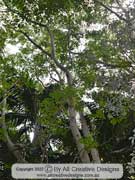
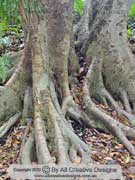
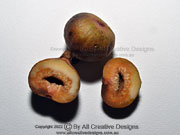
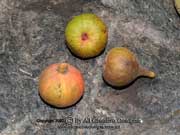
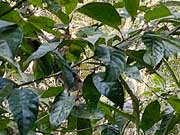
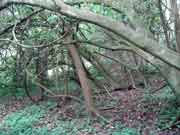
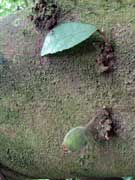
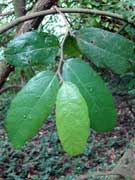
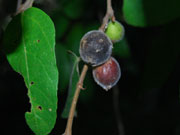
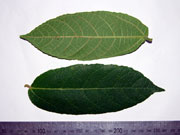
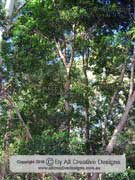
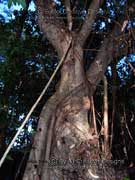
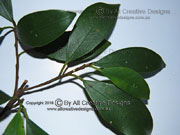
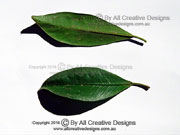
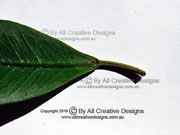
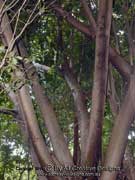
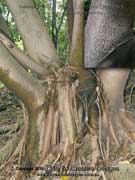
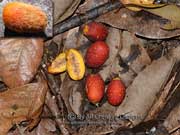
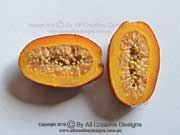
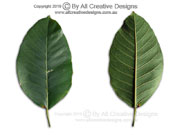
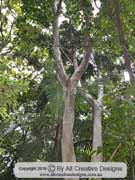
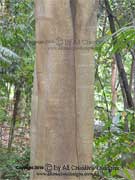
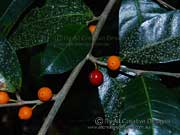
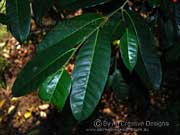
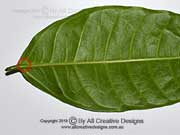
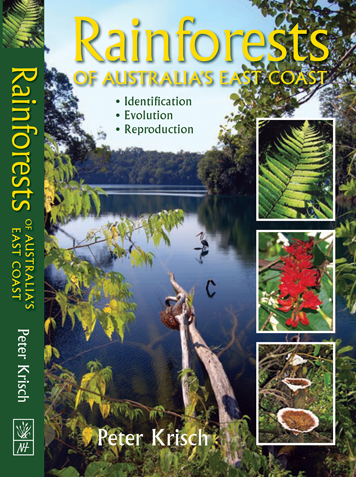
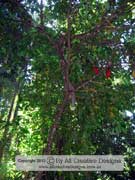
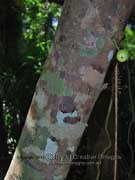
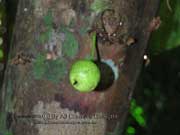
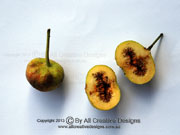
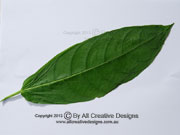
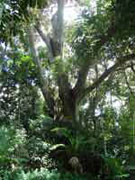
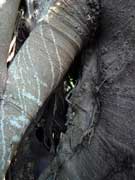
tn.jpg)
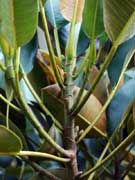
tn.jpg)
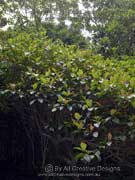
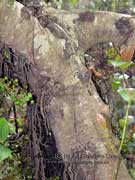
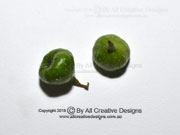
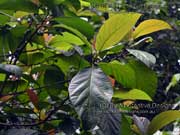
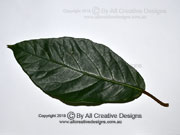
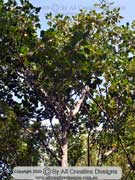
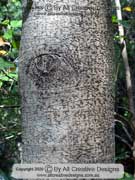
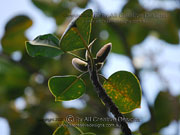
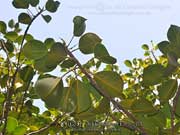
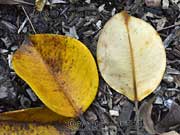
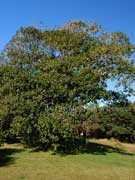
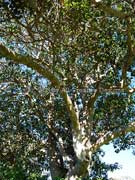
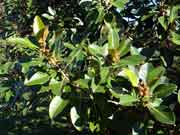
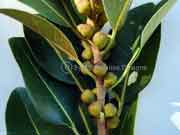
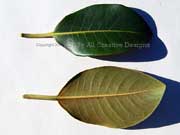
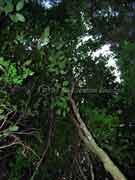
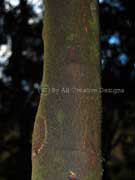
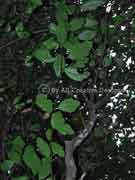
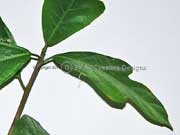
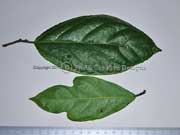
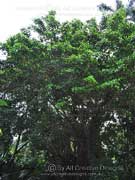
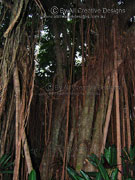
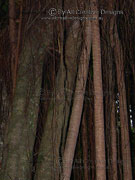
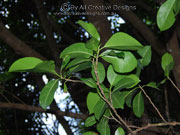
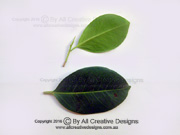
tn.jpg)
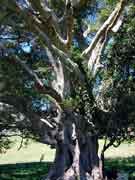
tn.jpg)
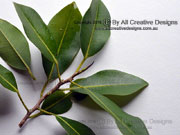
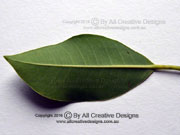
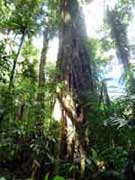
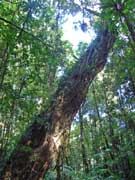
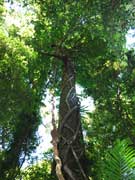
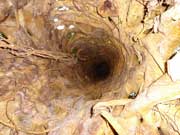
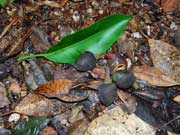
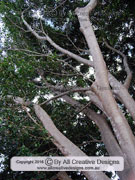
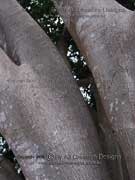
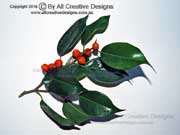
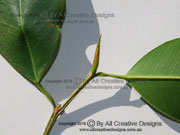

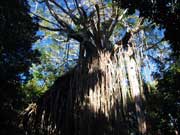
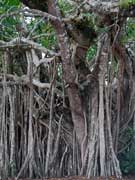
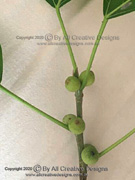
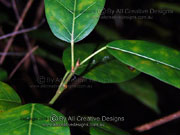
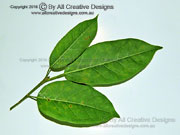
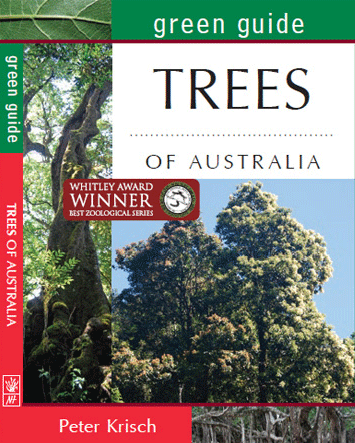
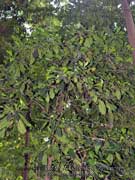
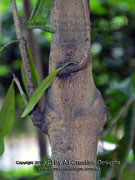
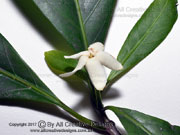
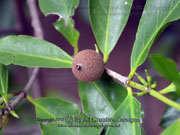
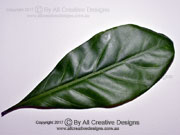
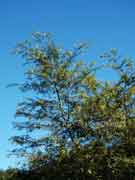
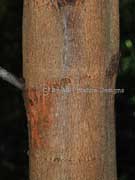
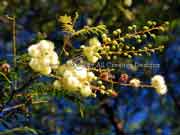
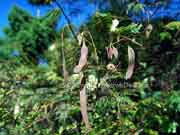
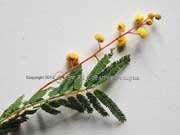
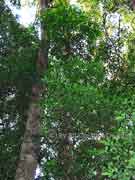
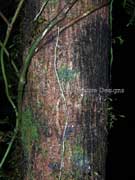
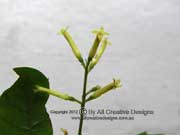
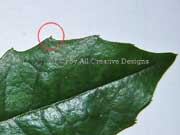
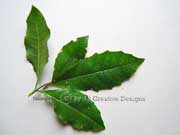
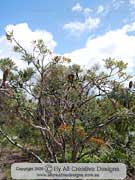
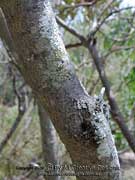
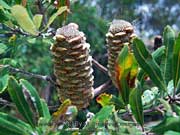
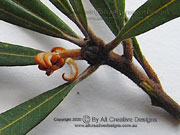
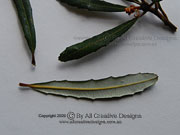
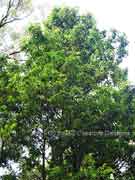
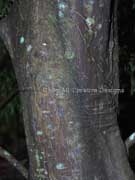
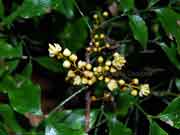
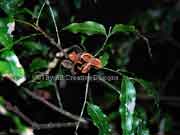
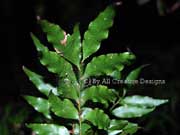
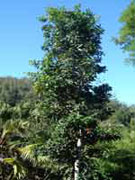
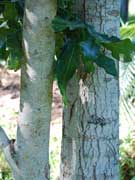
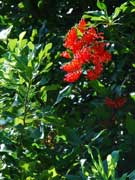
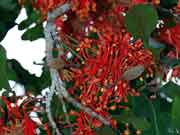
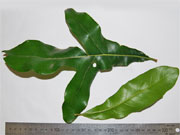
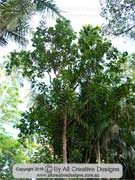
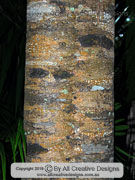
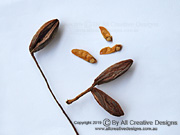
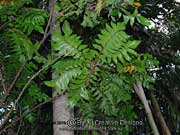
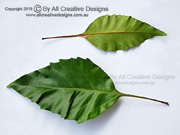
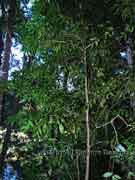
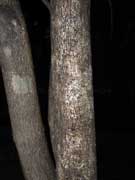
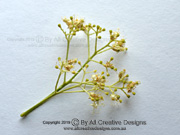
tn.jpg)
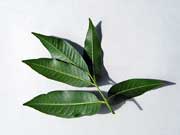
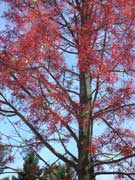
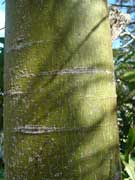
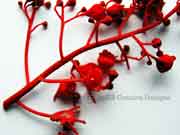
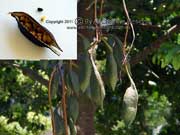
tn.jpg)
